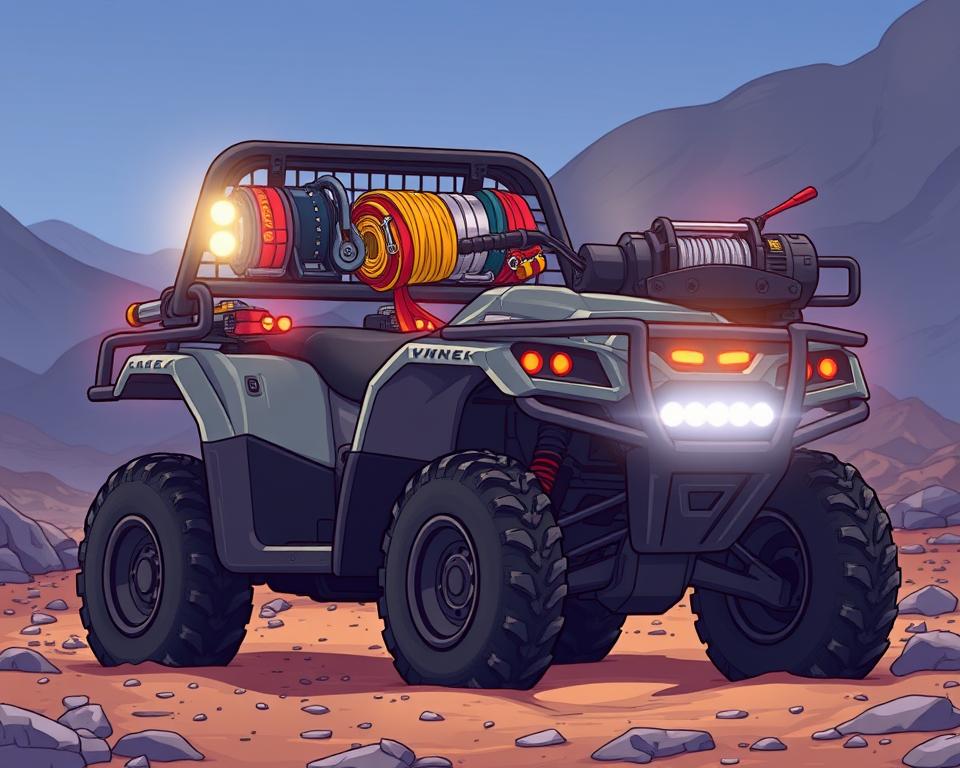Essential ATV Off-Road Checklist for Safe Riding
It might surprise you to discover nearly about 450,000 ATV-related injuries are treated in U.S. emergency rooms each year? That startling statistic underscores why off-road safety and preparation are essential. The Essential ATV Off-Road Checklist is your guide to a safe and enjoyable ride. It covers everything from rocky trails to sand dunes. With the right safety gear and RZR parts essentials, you can minimize risks and boost your adventure.
Significant Points
- Start with safety: follow this checklist for full prep.
- An ATV safety gear checklist is vital for protecting yourself during off-road rides.
- Regular maintenance is key to keep your ATV in top shape.
- Stay fueled and hydrated for peak performance.
- Learn to use navigation tools to avoid getting lost on off-road routes.
- Weather can flip fast—be ready with proper gear.
- Always carry essential tools and recovery kits for on-trail repairs and emergencies.
Understanding the Importance of Safety Gear
Safety is non-negotiable for every off-road trip. Riding an ATV is thrilling but comes with risks. Proper gear guards you against mishaps. Gear up correctly with this ATV safety gear checklist.

Essential Protective Gear
Maximizing protection involves several key items:
- Helmets: Only DOT-certified lids will protect your skull.
- Goggles: Protect your vision with wraparound goggles.
- Gloves: Gloves help you hold on and protect your skin.
- Boots: High boots shield your feet and ankles.
- Body Armor: Chest and back armor add vital protection.
- Neck Protection: Neck braces can help reduce the risk of spinal injuries.
Emergency Preparedness
Don’t overlook your emergency kit. A well-packed kit might save your life. Key items to include are:
- First aid kit
- Multi-tool
- Tire repair kits
- Portable air compressors
- Emergency blankets
- Whistles
- Matches
ATV Equipment for Optimal Performance
Gear choices affect how well your ATV runs. Knowing the must-have ATV equipment ensures you’re ready for any journey. Routine checks keep your ATV working its best.
Must-Have ATV Equipment
- All-Terrain Tires: Terrain-specific tires keep you glued to the track.
- Cargo Systems: Keep tools and spares within reach.
- Quality Fuel Tank: Never run low—use a proven fuel tank.
- Medical Kit: Stock your kit with bandages, antiseptic, and meds.
Regular Maintenance for Longevity
Establishing a consistent maintenance routine is vital. Regular inspections should encompass:
- Checking air filters to keep the engine running smoothly.
- Lubricating the chain to ensure optimal performance.
- Inspecting brakes for safety before each ride.
Follow these steps to prep your ride for every trail.
The Essential ATV Off-Road Checklist
Preparing for a ride is more than just hopping on your ATV. Use this pre-ride checklist to avert trouble before it starts. Every point matters—don’t rush. A little prep goes a long way.
Pre-Ride Inspection Basics
Before any off-road journey, a pre-ride inspection is vital. Catch faults early with a fast inspection. Key elements to check include:
- Tire pressure and tread condition
- Fluid levels such as oil and fuel
- Brakes and controls functionality
- Operational lights and horn
- Chain or driveshaft integrity
T-CLOC Inspection Method
Use T-CLOC for a thorough pre-ride check. It covers Tires and Wheels, Controls, Lights, Oil and Fuel, and Chain/Driveshaft. This method ensures all critical areas are covered:
| Inspection Area | Checklist Items |
|---|---|
| Tires and Wheels | Check tire pressure, inspect tread depth, look for damage |
| Controls | Test brakes, throttle, and clutch for smooth operation |
| Lights | Ensure headlights, brake lights, and indicators are functioning |
| Oil and Fuel | Check oil level, inspect for leaks, and fill fuel tank |
| Chain/Driveshaft | Examine for wear, proper tension, and lubrication |
Spending a few minutes on this ATV maintenance checklist can make rides safer and more enjoyable. By checking these essential components, riders can avoid breakdowns.
Hydration and Nutrition for Long Rides
Stay fueled and hydrated for peak performance. Always carry more water than you think you’ll need. Water packs help maintain endurance and alertness. Pack high-energy bites to keep you going.
Importance of Staying Hydrated
Dehydration leads to poor decisions and slow reflexes. It’s important to drink water consistently, not just when thirsty. Hydration bladders track consumption at a glance.
High-Energy Snacks to Pack
The right fuel makes the ride smoother. Opt for non-perishable items that are easy to consume. Some ideal choices include:
- Protein bars
- Nut mixes
- Dried fruits
- Beef jerky
Grab-and-go snacks let you refuel on the move. Ensure to pack a variety to keep your energy levels high and your taste buds satisfied.
Navigation Tools for Off-Roading Adventures
Lose fear of getting lost with the right nav gear. A dependable nav setup means you’ll always find your way.
Advanced GPS Systems
High-end GPS units guide you through the wild. Look for features like offline maps and a long-lasting battery. Garmin and TomTom lead the pack for trail GPS.
Traditional Navigation Aids
Technology is key, but traditional tools are also essential. Waterproof maps and compasses are vital backups when your GPS fails. Knowing how to use these tools is critical, adding security to your excursions. Combining advanced tech with traditional aids prepares you for any situation on your journey.
Communication Equipment for Safety
When phones fail, two-way radios deliver. Clear comms keep your group coordinated. Knowing you can call for help reduces stress.
Don’t split up without radios in hand. Opt for radios rated for miles of reach. They allow for real-time updates on any changes or hazards. When choosing two-way radios, look for models with:
- Rugged, waterproof design to resist the elements
- Long battery life for extended trips without needing a recharge
- Multiple channels for clear communication without interference
Always include comms in your gear list. Group comms save time and reduce risk. Radios cut through noise and barriers. With the right tools, your off-road trips will be smoother and more enjoyable.
Self-Rescue Gear for ATV Riders
Self-rescue gear is as vital as your helmet. Relying on yourself starts with proper rescue tools. Being self-sufficient elevates confidence and safety.
Winches and Recovery Kits
A winch can drag you out of any rut. Kit up your winch for maximum extraction muscle. Recovery kits usually include:
- Tow straps
- D-rings
- Recovery boards
- Gloves
Understanding how to use this gear boosts ATV riders’ confidence in navigating rough terrain. Don’t let stuck wheels end your ride.
Trail Recovery Essentials
Winches are just the start; several trail recovery essentials are also critical for off-road adventures. These include:
| Equipment | Purpose |
|---|---|
| Recovery Straps | Used for towing or pulling ATVs out of tight situations. |
| Shovel | Helps clear obstacles and dig out vehicles when stuck. |
| Traction Mats | Provides grip under tires in muddy or slick conditions. |
| Portable Air Compressor | Enables quick tire inflation after deflating for better traction. |
Be the rider who never gets stranded. Skills plus gear equal top-tier off-road safety.
Staying Adaptable: Preparing for Weather Changes
Weather variability is a major challenge in off-roading. Be prepared for sun, rain, or wind at any moment. An ATV gear checklist must include weather gear to cover all bases.
Dress in layers to stay comfortable. Begin with a moisture-wicking base layer to manage sweat. Fleece or wool gives you warmth on demand. Lastly, have a waterproof and wind-resistant outer shell. Stay dry and warm through all conditions.
Weather-Appropriate Clothing
- Waterproof Jackets: Stay dry when the sky opens up.
- Breathable Pants: Pants that vent yet keep out the rain.
- UV Gear: Shield skin from sunburn with proper apparel.
- Cold-Weather Gloves: Keeps hands warm and functional during colder rides.
Quality weather gear is a must for a great off-roading experience. Comfortable riders ride longer and safer.
Tools for On-Trail Repairs
Having the right tools for on-trail repairs is key to a safe and enjoyable off-roading experience. It’s vital to carry reliable ATV repair tools. These tools help address minor breakdowns or issues that may arise during your adventure.
Must-Have Tools and Kits
Keep these tools handy at all times. Pack only the essentials—no junk. Critical ATV repair tools might include:
- Tire irons for changing flat tires
- Pliers for gripping and cutting
- Wrenches for various sizes of bolts and nuts
- A multi-tool for versatility
- Spare items such as spark plugs and electrical wire
- Duct tape for quick fixes
Tools at hand mean no surprises.
Basic Emergency Supplies
Emergency items can be lifesavers. These supplies help ensure your safety in challenging situations:
- First aid kit for injuries
- Flashlight with extra batteries for night-time visibility
- Emergency whistle for signaling assistance
- Reflective triangles or flares to warn other riders
- Water and high-energy snacks for sustenance
Be ready for the unexpected. Your safety net on the trail.
The Bottom Line
Well-planned rides are the best rides. Using the Essential ATV off-road checklist and acquiring gear from trusted sources is key. This ensures you’re ready for any terrain.
Load up on safety, navigation, and comms gear. Prep wisely for peak thrills and protection. It lets you enjoy the thrill of off-road adventures without worry.
Gear up, stay sharp, and savor every off-road second. Every leg of the trip matters. Check this list, then conquer nature.
Frequently Asked Questions
What should I include in my ATV safety gear checklist?
Start with a DOT helmet and sturdy goggles. Gloves, suitable footwear, and body armor are also necessary. Neck braces help guard your spine. Remember to pack an emergency kit with a first aid kit and multi-tools for preparedness.
How do I keep my ATV in top shape?
To maintain your ATV, regularly check air filters and lubricate the chain. Don’t ignore brake checks. A consistent maintenance routine extends your machine’s life and keeps it ready for off-road adventures.
What does the T-CLOC inspection method entail?
T-CLOC inspects five critical systems. It includes checking Tires and Wheels, Controls, Lights, Oil and Fuel, and Chain/Driveshaft. This ensures your ATV’s critical components are in working order before hitting the trails.
How much water should I bring on an ATV trip?
Overestimate your water needs. Stay topped off to avoid dehydration. Use a hydration bladder for quick sips.
Must-have navigation tools for ATV trips?
Use an off-road GPS unit. Combine this with traditional aids like waterproof maps and compasses.
Why carry two-way radios?
Radios prevent isolation when cell fails. Areas with limited cell service highlight the need for reliable two-way radios.
What self-rescue gear should every ATV rider carry?
Be ready with winch and recovery essentials. Include straps, shackles, and traction boards.
Tips for weather readiness off-road?
Use a base, mid, and shell layering system. Waterproof gear is necessary to stay dry during unexpected rain. Don’t forget sunscreen and UV-blocking apparel.
What tools should I pack for on-trail repairs?
A compact tool set lets you fix flats and loose bolts. Don’t forget duct tape and electrical wire.

